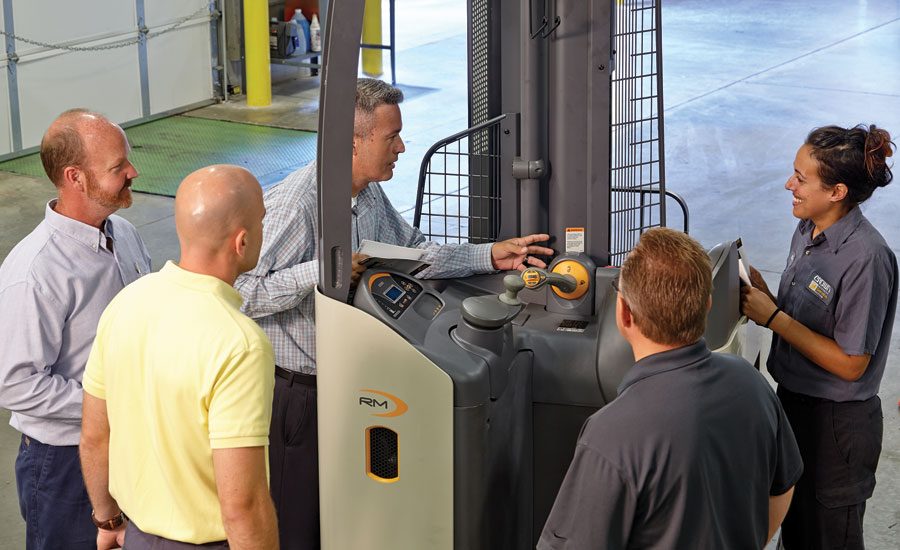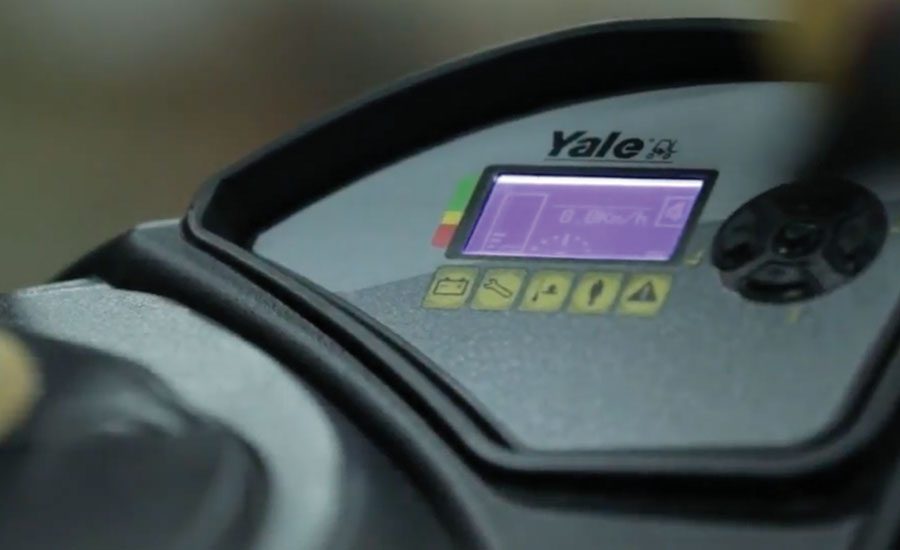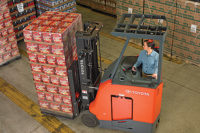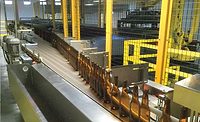Although the main tasks of a warehouse are to produce and store products, warehouse managers have an even bigger day-to-day goal: safety. For the Industrial Truck Association, safety has taken center stage through its sponsorship of National Forklift Safety Day, which took place June 14. On its website, the association highlights that the goal of the day was to spread awareness and education to customers, the public and government officials about safe forklift practices.
For lift truck manufacturers, ensuring operator safety is not something they take lightly. “Safety is a top priority for every organization,” says Jim Gaskell, director of global technology and business development for Crown Equipment Corp., New Bremen, Ohio. “It certainly takes a lead role when forklifts are being utilized in warehouse and distribution center environments. A full-pallet load is heavy, and safety procedures should be taken, especially when it is being maneuvered at high heights.”
Among the ways that Crown Equipment addresses this is through its Demonstrated Performance (DP) Training programs, which are designed to help its customers promote forklift safety, improve productivity and reduce total cost of ownership, Gaskell says.
Hiring practices also can be valuable when it comes to forklift safety. Mick McCormick, vice president of Warehouse Solutions for Yale Materials Handling Corp., Greenville, S.C., notes that hiring qualified operators will not just support safe operations but also productivity. Once these qualified operators have been hired, it also is vital to incorporate ongoing, comprehensive training, he adds.
“Operators with poor or insufficient training can create unsafe situations for themselves and coworkers, and reduce their ability to meet productivity standards,” McCormick says. “According to the National Safety Council, operator error accounts for 70 percent of lift truck accidents. With more effective forklift operator training, accident rates may be reduced by nearly 30 percent, keeping throughput high and downtime low.”
Toyota Material Handling U.S.A. Inc., Columbus, Ind., also highlights the importance of working with its clients to ensure that safety measures are executed when using its products. “Our dealer network offers safety-focused services like on-site warehouse safety audits, operator training and other services for customers,” says Martin Brenneman, electric product planning specialist for Toyota Material Handling. “Our website has a library of forklift safety content, including videos, safety checklists, tip sheets and more.”
In addition to education and awareness, forklift manufacturers are improving their portfolio of products with better safety capabilities.
“Crown has introduced a number of new features and technology enhancements to our forklifts to improve the physical safety of forklift operation,” Crown Equipment’s Gaskell says. “One such feature is the Crown OnTrac Anti-Slip Traction Control System, which is designed to assist the truck from slipping on wet, dusty or sealed floors.”
Growing assortment
Although safety remains a top concern among forklift operators, accommodating the increasing number of SKUs in a beverage warehouse is another challenge for which operations managers must account.
“Managing the supply chain and moving products is only becoming more complex because of the increase in SKUs and increasing consumer expectations for availability and variety,” Gaskell says. “As a result, we are seeing investments shift as beverage providers evaluate their distribution networks, increase the number of products offered and diversify their delivery channels. Beverage warehouses are increasingly interested in technology and equipment that enables them to be more responsive to the changing interests and expectations of the consumer.”
Toyota Material Handling’s Brenneman also notes the challenges that SKU proliferation has created within warehouse operations.
“SKU proliferation and inventory control for any customer are a challenge as too much inventory [on] hand can lead to space-constraint concerns,” he says. “For the beverage industry, in particular, it is a concern as some beverage producers like to promote the ‘Born On’ date of their product to show the end customer the ‘freshness’ of their beverage. The longer the product sits in their warehouse, the closer it is to the expiration date.
“SKU proliferation has also increased the need for mixed-pallet loads,” he continues. “To accomplish this, beverage companies are using layer-picker attachments and implementing low-level order picking with electric pallet jacks.”
An evolution of this trend also has been the demand for various pallet sizes. “This impacts [the] users of electric pallet jacks the most, since a pallet jack has the load wheels in the forks and needs an open slot in the pallet for them to drop through,” Brenneman says. “If a customer uses the same size pallet all the time, they can order the forks to match that size. Customer’s handling multiple pallet sizes need the forklift to adapt to the pallet.”
To accommodate this growing need within beverage warehouses, Toyota Material Handling provides customized load backrests.
“The backrest is able to be quickly adjusted to different pallet sizes in order to keep the opening in the bottom of the pallet lined up with the load wheels of the electric pallet jack,” Brenneman says.
Also recognizing the impact that mixed pallets are having on beverage warehouses, Crown Equipment’s Gaskell notes how the company developed its Crown’s QuickPick Remote order picking system.
“The system uses semi-automated truck navigation technologies to reduce low-level order picking walk steps, thereby increasing productivity, reducing operator fatigue and improving safety,” he says.
Yale Materials’ McCormick notes that in response to SKU proliferation, slotting strategies also have become more vital to warehouse operations.
“The use of multi-level lift trucks can expand the so-called ‘golden zone’ of the pick face, enabling operators to easily access products stored at higher levels,” he says. “Combined with a slotting strategy optimized for this picking range, this can reduce pick time, rack requirements, operators and overall cost per case.
“In practice, this means that truck with a rider platform that elevates 39-inches off the floor can allow DC managers to slot fast-movers in the zero- to 6-foot zone and slow-movers in the 6- to 10-foot zone — all quickly accessible by one operator on a single truck,” McCormick continues. “This can yield 33 percent more available pick space and 30 to 140 percent more slots in the existing footprint. As beverage operations face increasing SKU counts, this offers a solution to handle this SKU proliferation and more orders without overhauling the existing facility.”
Improving operations
Another trend proliferating throughout the distribution portion of manufacturing is direct store delivery (DSD). McCormick notes that investing in new equipment can help streamline this process.
“This is an area in which advances in technology can bring greater efficiency,” he says. “In its MPB045VG walkie pallet truck, Yale offers the first UL-recognized lithium-ion battery pack in the lift truck industry. This means a shorter, more compact 6-inch battery compartment to decrease the length of the truck and provide better maneuverability in congested areas and tight spaces.
“The flexible charging capabilities are another important aspect for DSD operations,” McCormick continues. “Lithium-ion batteries are suitable for opportunity charging on-site and in-transit using a standard 120-volt wall outlet. Unlike traditional lead-acid batteries, the lithium-ion option requires no off-gassing and does not experience negative memory effects — this provides the flexibility DSD operations need to keep deliveries going without having to return home to recharge or replace the battery.”
Crown’s Gaskell also highlights how alternative power options like lithium-ion batteries and hydrogen fuel cells can improve operations as well as aid in sustainability goals.
“There are a number of benefits provided by lithium-ion batteries that make them an option worth considering under certain circumstances,” he says. “For instance, they are generally more efficient than lead-acid batteries and have longer run times. While this technology still is costly relative to lead-acid batteries, early adopters are starting to conduct trials and pilot studies to better understand the benefits of the technology for their specific applications and needs.
“Fuel cells have been piloted in a number of large warehouses over the last several years, and some of those early adopters are now transitioning from government-sponsored trials to full-site conversions,” he continues. “The technology, as applied to forklifts, has shown some promise in addressing the issues inherent with lead-acid batteries.”
Another option for warehouse managers to improve operations is by investing in data collection for their forklifts, experts note.
“Crown envisions a connected warehouse in which the forklift becomes not only a roving sensor that reaches parts of the warehouse [that] no other system is reaching, but is also a hub that collects data from various other devices, acts on this data and consolidates and analyzes it for other systems,” Gaskell says.
The company offers its Crown InfoLink wireless fleet and operator management system, which allows beverage companies to monitor and manage the efficient use of forklift fleet and total operations, he notes.
Yale Materials’ McCormick also notes the benefits associated with data collection systems for lift trucks.
“For lift truck fleets, telemetry programs can produce a wealth of relevant data insights for quick conversion into actionable business intelligence,” he says. “Yale Vision, a telemetry system that can evaluate utilization and maintenance information alongside expected demand and specific truck applications, allows fleet managers to make quick, informed decisions about fleet size and composition. This helps eliminate running excess trucks, which can be a huge operational cost savings. Additionally, properly utilized telemetry analytics can help refine periodic maintenance schedules to ensure sufficient support while avoiding overspending.”
Toyota Material Handling also is seeing a proliferation of this connected forklift trend, and recently partnered with Sprint to launch T-Matics MOBILE, a forklift-based vehicle management system. The system is designed to increase productivity, profitability, safety and operational benefits, Brenneman says.
“Toyota will offer T-Matics MOBILE services through both embedded and aftermarket solutions that leverage Sprint’s advanced Machine-to-Machine technology,” he says. “[It] is an individual forklift-based cellular telematics solution with a full-featured set of monitoring and analytic capabilities to generate reports on both individual forklifts and entire fleets to track forklifts for better operational visibility; gain and analyze unique data; and facilitate data-driven decisions regarding your forklift fleet.”





